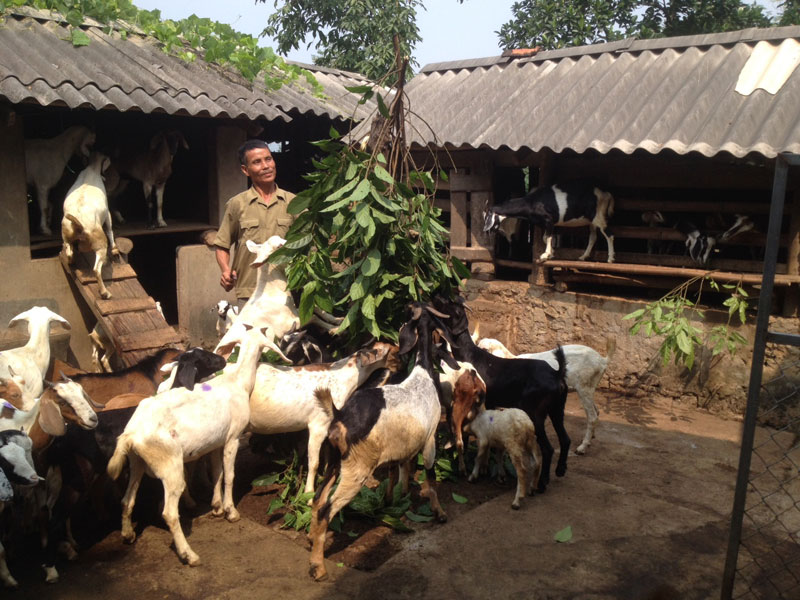
(HBO) - Currently, Lac Thuy district is speeding up the restructuring of the agricultural sector in the direction of depth and sustainability associated with the construction of new rural area.

Goat raising model of Mr. Nguyen Van Nhan’s
family, in Dong De village, Dong Tam commune (Lac Thuy district)
It can be said, after 10 years of
implementation of the Resolution of three agricultures, Lac Thuy district has
achieved many encouraging results, the rural economy developed quite well. Up
to now, the average income per capita reached at 34, 6 million VND; the rate of
poor households in rural areas decreases to 15.83%, decreasing annually from
2-3% / year. The growth rate of agriculture, forestry and fishery reached an
average of 9.9% / year, the production value of agriculture reached over 600
billion VND/ year. The fruit trees grow well, especially citrus fruit with area
of 996 hectares, products are popularly favored by the market, is gradually
forming concentrated production area. It initially set up many models of high
economic efficiency for producers such as growing oranges with income of over
400 million VND / hectare, Dien grapefruit planting for the income of 250
million VND / hectare; planting sugarcanes, bananas, dragon fruit, green
pumpkin to earn over 150 million VND / hectare. In 2017, the district
successfully built a collective trademark for Lac Thuy orange. In 2018, the
district will build the trademark for the main agricultural products like Lac
Thuy chicken, Lac Thuy goat.
Stepping into the implementation of the new
rural area development program, from a low starting point, in 2010, the
district reached 4, 92 criteria / commune on average. Up to now, the average
number of criteria is 15, 69 criteria / commune, which is considered to be one
of the leading districts in new rural area construction by the province. By the
end of 2017, the whole district has 5 communes meeting the new rural area
standards. In the construction of new rural area, socio-economic structure of
agriculture and rural areas has been gradually developed. The traffic is to
ensure smooth access, 94.5% of commune roads has been concrete; the irrigation
works have been upgraded and improved to ensure irrigation for production and
daily life needs of the local people. 100% of households have access to
electricity. There are 24/35 national standard schools. Cultural facilities are
built and upgraded each year to ensure the construction criteria of new rural
area.
According to data from the Hoa Binh Provincial Party Committee, the industrial production index for the first six months of 2025 is estimated to have increased by 20% compared to the same period last year. This marks the highest year-on-year growth rate for this period since 2020.
In the first six months of 2025, Hoa Binh province’s export turnover was estimated at 1.145 billion USD, marking an 18.11% increase compared to the same period in 2024. Import turnover was estimated at $ 804 million, a 17.15% increase, which helped the province maintain a positive trade balance.
The lives of the ethnic minority farmers in Tan Lac district have gradually improved thanks to the new directions in agricultural production. This is a testament to the collective strength fostered through the professional associations and groups implemented by various levels of the district’s Farmers’ Union.
With the motto the "product quality comes first,” after nearly one year of establishment and operation, Muong village’s Clean Food Agricultural and Commercial Cooperative, located in Cau Hamlet, Hung Son Commune (Kim Boi district), has launched reputable, high-quality agricultural products to the market that are well-received by consumers. The products such as Muong village’s pork sausage, salt-cured chicken, and salt-cured pork hocks have gradually carved out a place in the market and they are on the path to obtaining the OCOP certification.
In the past, the phrase "bumper harvest, rock-bottom prices" was a familiar refrain for Vietnamese farmers engaged in fragmented, small-scale agriculture. But today, a new spirit is emerging across rural areas of Hoa Binh province - one of collaboration, organisation, and collective economic models that provide a stable foundation for production.
Maintaining growing area codes and packing facility codes in accordance with regulations is a mandatory requirement for agricultural products to be eligible for export. Recently, the Department of Agriculture and Environment of Hoa Binh province has intensified technical supervision of designated farming areas and packing facilities to safeguard the "green passport" that enables its products to access international markets.



